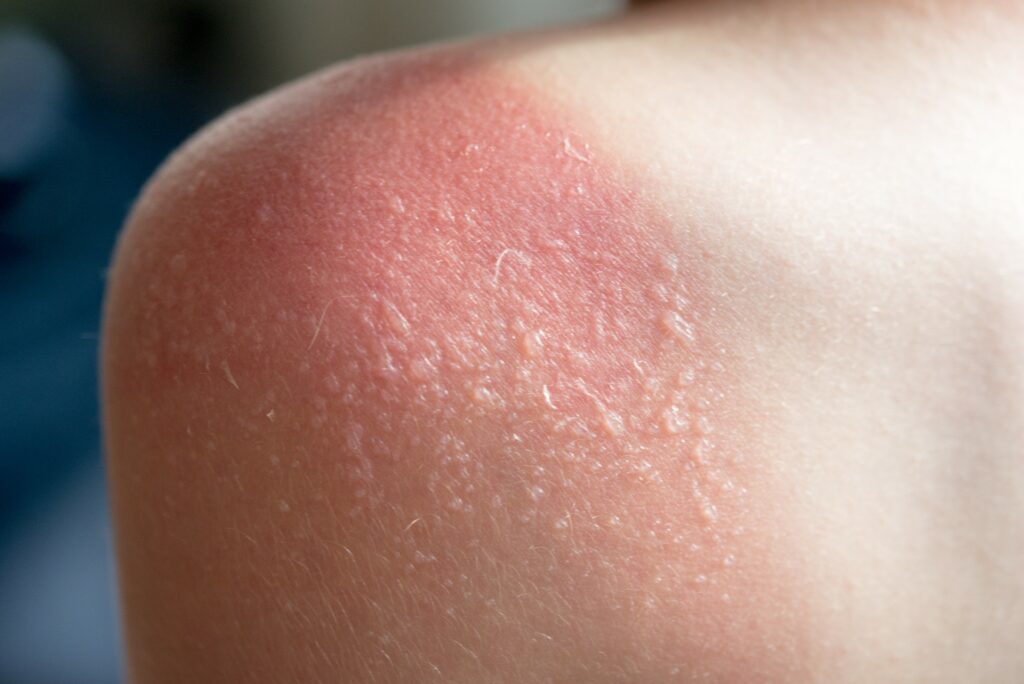Sunburn Prevention, Treatment, and Risks

Sunburns are not something to take lightly, and keeping an eye on the UV index is one way to protect you and your family this summer. Even cloudy days can trick people into thinking they don’t need to apply or reapply sunscreen, but nothing could be further from the truth. Sun exposure is a known way to give the body vitamin D, but unprotected exposure to the sun can have serious side effects. Skin can become damaged from sunburns, blistering, and peeling, leaving skin vulnerable to infections and skin cancer. This summer, both UVA and UVB will be out in force. UVB rays can cause skin cancer, while UVA rays are related to signs of premature aging. Using sunscreen is not optional; other measures to protect skin will keep it healthy and minimize exposure to harmful UV rays.
When people get sunburned, their skin is overexposed to UV radiation from the sun and fake tanning beds. The radiation damages skin cells and causes the body to respond to defend itself. The skin’s defense results in pain, discomfort, peeling, and blistering. In extreme cases, those experiencing severe sunburn may also be fatigued, dehydrated, and disoriented.
There is No Exception
Just because it is overcast doesn’t mean the sun’s rays can’t cause damage. Every skin color is at risk from the sun’s dangerous rays. Even someone claiming they “tan well” or “don’t burn” is ignoring that the sun’s rays are harsher now than before, and they are in denial that they are putting themselves at risk. UV rays penetrate clouds and glass from windows, leaving everyone exposed. There is no reason to leave the house without sunscreen anymore. Daily moisturizers and make-up products can all be found with some form of SPF protection, so do not skip this critical step daily.
Risks of Overexposure
Severe sunburn can have significant long-term repercussions on the skin’s health. Prolonged or repeated exposure to UV rays heightens the risk of skin cancer. The sun also speeds up the skin’s aging process, depleting it more quickly through repeated exposure. Wrinkles, sagging skin, and discoloration are directly connected to too much sun exposure.
Treating a Sunburn
You can use at-home remedies to ease discomfort and aid healing for mild sunburns that don’t need medical attention. Aloe vera gel, especially when cooled in the refrigerator, soothes inflammation and ease pain. Cool showers or cold compresses can also constrict blood vessels and reduce swelling caused by the burn. A sunburn that goes away on its own is manageable with some extra care, but in some cases, a severe sunburn should be seen by a medical professional.
Severe Sunburns
In some cases, severe sunburn should be seen by someone with medical training. Symptoms such as blistering, severe pain, spiking fever, chills, and nausea are signs of getting help from someone with experience. Individuals with any of these symptoms should seek medical attention to avoid skin infections and other illnesses related to the burn.
When large body areas are sunburned, corticosteroid cream or prednisone may be required to reduce inflammation and help ease the pain. Corticosteroids suppress the body’s immune response and reduce swelling. Sometimes, over-the-counter remedies are not enough.
Prevention is Best
Sunburn prevention is always better than addressing it after the fact. Take measures every day to avoid sunburn, especially when you know you will be in the sun. If you know you won’t be diligent about reapplying at the beach, take a sun-protective shirt to wear if you fall asleep. Take a proactive approach to caring for your skin – the sun’s harmful rays are nothing to be taken lightly. As the ozone layer expands, the sun’s rays become more extreme every summer. It is not worth the risk of skin cancer, early signs of aging, or long-term skin damage.
Sun’s Upside
With sunburn survival tips, people can protect their skin during sunny adventures! The sun offers some benefits, like vitamin D absorption and mental health boosts. Some sun exposure also helps the body’s internal clock know when to sleep—this is why people in places that have darkness 24 hours a day may suffer from depression.
It is essential to prioritize sun safety for you and your family. Knowing the risks, how to prevent it, and how to treat sunburn is half the battle. Always wear sunscreen, which must be reapplied when spending time in the water or sweating. Prolonged time in the sun should include protective clothing, hats, sunglasses, and time in the shade. Everyone can take an active role in sunburn prevention, and it starts with sharing what you know and reminding the people you love to reapply all day!
If you have suffered from severe sunburns and have scarring or skin concerns, contact Buckhead Dermatology today for an appointment. Dr. Straughn has been helping Atlanta residents manage their skin health for decades, and she would love to partner with you to get your skin looking the way you want it!
